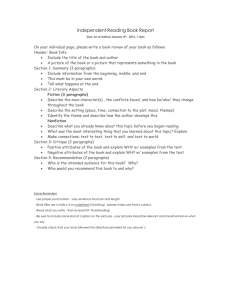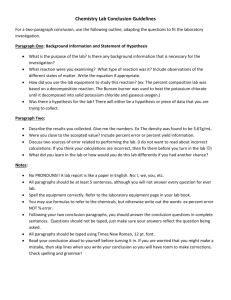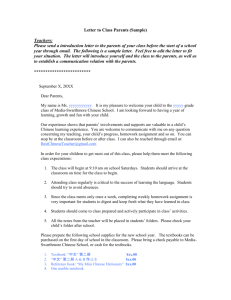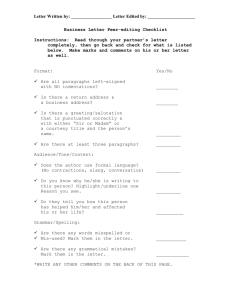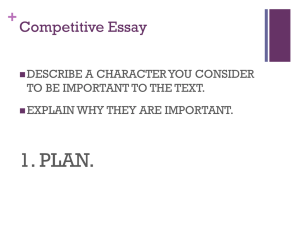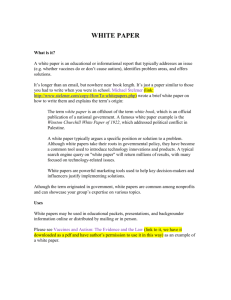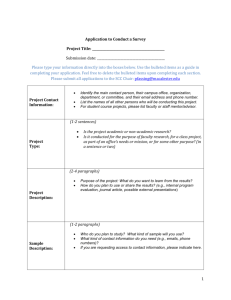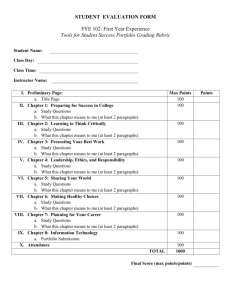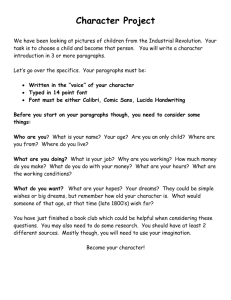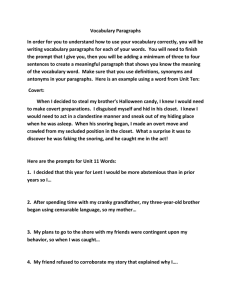Basic Scientific Writing in English Lecture 3
advertisement
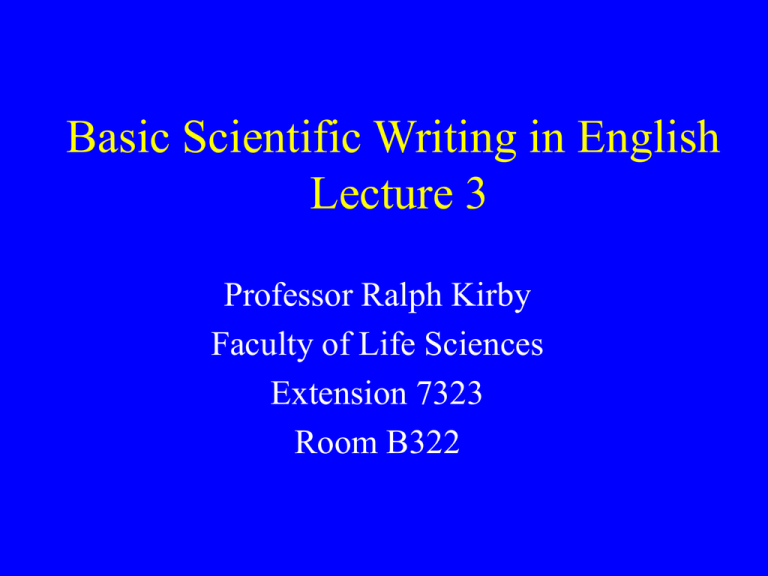
Basic Scientific Writing in English Lecture 3 Professor Ralph Kirby Faculty of Life Sciences Extension 7323 Room B322 Write the paper in English • It is much harder to translate directly into English without making many errors unless you have a lot of practice • Use the vocabulary that you have. • Use Simplified English with its limited vocabulary. You can make it read better later • Use the papers that you have from your literature search to help you – If you are using the same method, for example, refer directly in your paper – If you have modified the method, keep the same wording and add the changes – Use the introductions from papers to give you the content and style you want for your introduction – Do not plagiarize, but science does allow you to say things in the same way as others, unlike many other subjects • Write the paper in stages – Do an outline, in Chinese if you want, of what you want the paper to say. – Decide on the journal – Get the Instructions to Authors and a hardcopy of a recent paper on a similar subject – Create a structure for the paper, also in Chinese if you want, for each section of the paper • Introduction, Materials and Methods, Results, Discussion – Start writing one section, say the Material and Methods – When you have a 1st draft, start on a 2nd section, the Results perhaps – Then the Introduction and finally the Discussion – Now put all these 1st drafts together • Now get the model paper and check that you have the format correct and that you have the heading as they should be • Look at the Instructions to Authors and decide what is missing • How about a title page. – You might have wanted to invent a title earlier. That’s OK. But the title is not the only thing needed on the title page. The Instructions will tell you • You will need an abstract and this usually has a word limit • You will need references • You will need Tables and Figures The Introduction • This should tell why the work was done • Keep it relatively short – Explain the general field including what is already known about the question • 1-3 paragraphs – Describe other scientists findings and explain how your work fits in and may change the prevailing view • 1-3 paragraphs – Specify exactly what the paper addresses and how it does so, preferably as an hypothesis. Outline your experimental approach and why it is different • 1 or at most 2 paragraphs • Do not outline in detail your results and conclusions. Some journals allow a brief outline of your answers (Check model papers for this), but it should not be more than two or three sentences The Materials and Methods • Can have a variety of names. Check your model paper • Do not make this a laboratory manual. You are talking to experienced scientists – Refer to methods published in previous papers as much as possible – Write in a concise way, that allows the experiment to be reproduced by a trained investigator • Start with the animate and inanimate items used and where you got them from – Include any legal requirements for human or animal subjects here • Then explain in chronological order, if possible, the experiments carried out and why. Alternatively, you can parallel how you present the results • Finally discuss any statistically procedures and computer programs used The Results • This should be the easiest as you will already have presented them to your research group etc • Present the results logically – From most simple to most complex – Chronologically – In an order that argues the case you are making • Here is where you first refer to any Tables and Figures – Do not repeat what is presented in these, merely refer when needed to a particular Table or Figure • Only include relevant results – Even if the experiment worked beautifully but didn’t show anything useful, don’t include it – Do include any results that contradict your hypothesis The Discussion • • • • • • • • • • This can be the hardest section to write This is where most papers get rejected Most discussions are too long Use the discussion to put your results into context Explain what your results mean in terms of the introduction Do not repeat what is said in the Introduction more than you need to Do not repeat what was said in the Results Point out any exceptions Show how the results agree/disagree with previous work Discuss the theoretical and practical implication of the work Conclusions • This can make up the last couple of paragraphs of the Discussion. Look at the model paper • Define the significance of the paper so there is no “so what!” effect • State the conclusions you draw from your work as clearly as possible • Summarize the evidence for each conclusion independently • Do not assume anything What next? • We have not looked at a number of things yet. – the title; tables & graphs; references; abbreviations – jargon, the most common style, grammar and spelling errors in detail, words and expressions to avoid – posters; oral presentations; reports • But we need to look at some real examples and that’s what we will do next Writing and Correcting a Manuscript • Needed, a English-Chinese/Chinese English dictionary – So it is possible to identify exactly what some words might mean in Mandarin, if necessary. • And an English Dictionary – So that we can look up the exact definitions of problem words in English • And a Thesaurus – So we can find alternative words (online or book)
